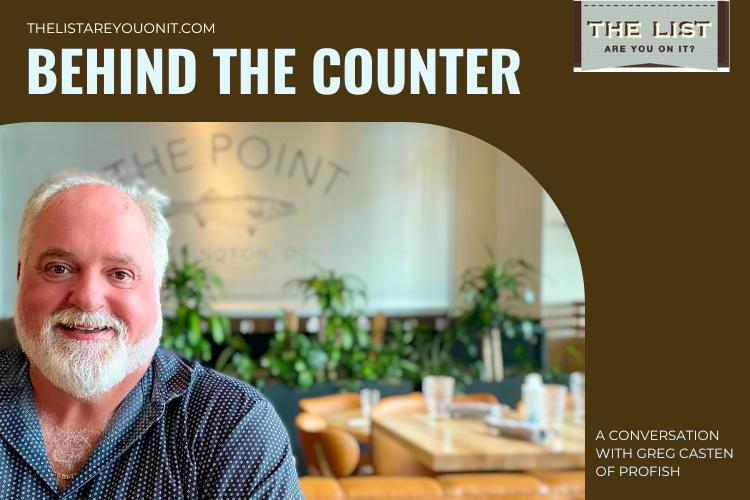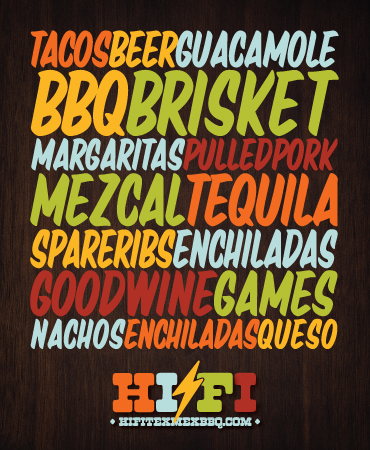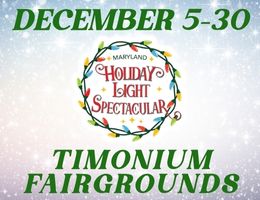
BEHIND THE COUNTER: A SPIRITED CONVERSATION WITH GREG CASTEN OF PROFISH
A good friend, Greg Casten, has been in the fish and food Industry for over 40 years. Greg has extensive experience with restaurant and fish operations. His Profish, Washington DC’s largest fresh seafood wholesaler, has resided in Ivy City for the last 35 years. With a few stints on lobster boats, his other works include Tony and Joe’s Seafood Place and Nick’s Riverside Grill. Greg and his business partner, Ron Goodman, created, developed, implemented, designed, and built Ivy City Smokehouse and Tavern. More recently they opened their successful waterfront restaurant, The Point DC, and with that, the Fish & Fire Food Group was born. With his fingers in so many (fish) spots TheList had a lot of questions for Greg and boy does he have answers:
Profish is one of the largest Seafood distributors in the DC Market — how do you keep up with the demand for fresh and sustainable fish?
For fresh fish, this is easy – experience and knowledge of the market. As a team, our buyers, and we have five different individuals purchasing across a spectrum of 900 different species or sizes. And with many things in life, seafood size makes a difference – in texture, flavor, and in sustainability. From a flavor or texture standpoint, some chefs will ask for smaller fish, while others demand the larger fillet and from a sustainability standpoint, with size, as a protection for pro-creation, it is illegal to harvest over 33-inch fish during certain periods.
Confusing no doubt – and each species will have mitigating factors surrounding these details – it is why experience, which truly only comes with YEARS inside the market and a constant, vigilant reference to markets and management that a buyer knows these details. Using this experience, and keeping an eye on the weather, and calendar throughout the season, a buyer will make a move daily to secure only enough fish to get to the next buy – which could be a week or a day away. Combine this with an expert staff who KNOWS how to handle fish, using ice that is specific to be in as close proximity to the fish meat as possible. Did you know that finely crushed ice is significantly better than a full cube (the full cube can create small pockets of air which in fact are slightly warmer, elevated temperatures ultimately cause the fish to become less flavorful, less firm, and therefore less desirable by the chef). Handling is critical as well as a knowledgeable buyer and packer who handle the fish properly, maintaining super fresh fish is a team effort.
As to keeping specific fish that are known for their sustainability, or the opposite avoiding those fish which are known for their species' fragility, this is a great question. As there are so many “definitions” (if you will) of sustainable fish, it's again knowledge of the particular fish and the harvest methods that allow buyers to make such decisions. Once a buy can rely on that source, it makes their job easier, but you still have to verify. With sustainability, some folks have issues, where others do not – like farm-raised salmon farm practices or where or how a particular fish is harvested – usually where translates into the how harvested as regions tend to fish the same.
Domestically speaking there are 242 wild fisheries and all but four or five have a sustainable plan – domestic fish is all pretty much sustainable unless an illegal harvest occurs – but imported fish – this is a difficult source to verify and monitor. And where this becomes an issue is with larger buy corporations – often they will define specific brand names or locations which is a great help in maintaining reliable sources.
How do you keep the public educated on the latest in seasonal offerings and technology in the fish industry?
Weekly newsletter, constant interaction with sales folks (our team meets daily – if not in person, virtually). Talking to our customers is so critical to their buying the right things (other than those on their menu permanently.)
How do you go from fresh fish to smoked fish?! Ivy City Smokehouse makes incredible smoked fish — what goes into making it so good?
Sourcing of the raw material – only specific farms, with a history of proving fresh salmon. With smoking, salmon is the number one seller (by far) and as it is farm-raised, it comes down to knowing the farm, knowing and trusting their logistics (salmon farms come from Chile, Norway, Canada, Faroe Islands, and each location source has its own issues and benefits. In our case, we want a FRESH raw material to start – most smoked salmon makers buy large amounts of frozen – at Ivy City, we use only FRESH salmon, which makes pricing and sourcing more difficult – but we believe the consumer can taste and feel the silky smooth texture and robust flavor that only a FERSH raw material can deliver.
Experience – my partner and smoke master Jesus Bercian has been smoking fresh salmon for almost 50 years, our three smokers, each capable of producing thousands of pounds in an individual batch have specific nuances. With founder and Michelin Chef Ron Goodman, Jesus and I developed the recipes and practices we use using engineers, electricians, and HVAC sub-contractors – smoking is mostly about temperature and airflow and the right amount of smoke application.
You do so much more than fish. The Fish & Fire Food Group is four restaurants: Tony & Joe’s, Nick’s Riverside Grill, Ivy City Smokehouse, and your latest addition The Point. What is your favorite attribute about each?
I really enjoy the people I work with and the business nature of it. That and I have always loved the thrill of seeing something to completion and immediately getting to try again. With a restaurant, the shift goes through a boom, then you sit down and say – wow – we just did 750 covers and not one complaint (or maybe just one or two ). In both of these businesses, mistakes have to go in the rearview mirror and you get to do it all again tomorrow – hopefully with ONE fewer mistake! It’s a great feeling of accomplishment and it happens over and over again – who wouldn’t want that exhilaration in their life!
As for my favorite attribute – with fish wholesale, it is constantly learning, and hearing about fish harvesting and the personal stories that occur daily with fishermen. With restaurants, it’s the comradery a staff gets when the heat is on! Both create bonds to the work
I am never the expert, always learning and that is really the most fun part.
Both Ivy City Smokehouse and The Point are located in new up-and-coming areas. What was the allure for you? Was there a risk?
No pain, no gain – I grew up poor and the only way to succeed was to take a risk – if you ask around – I am a risk taker – I love the thrill of the challenge – lord knows it’s not for the money! I guess it’s in my blood, probably comes from the early fishing days.
As the seasons change what are you most looking forward to seeing on your plate?
Wow – tough one. Stone Crab season just opened – really delightful (not to mention sustainable) and a real treat. Don’t be fooled by the frozen ones – the fresh crabs are worth the wait. I can never get enough flounder, I just love the fish, pan-fried, or stuffed with a crabmeat concoction! And Mahi is running right now off of Costa Rican coast and when freshly caught (we fly in daily) – it’s so sweet – it tastes like sugar to me. You know, it’s so funny with seafood, sometimes the favorite at one time of year is, to me, so much better at other times. The past few weeks have been a great time to buy hard-shell crabs – the first few days in November – best time – local, fat, full of mustard and so fun and filling.
Profish is one of the largest Seafood distributors in the DC Market — how do you keep up with the demand for fresh and sustainable fish?
For fresh fish, this is easy – experience and knowledge of the market. As a team, our buyers, and we have five different individuals purchasing across a spectrum of 900 different species or sizes. And with many things in life, seafood size makes a difference – in texture, flavor, and in sustainability. From a flavor or texture standpoint, some chefs will ask for smaller fish, while others demand the larger fillet and from a sustainability standpoint, with size, as a protection for pro-creation, it is illegal to harvest over 33-inch fish during certain periods.
Confusing no doubt – and each species will have mitigating factors surrounding these details – it is why experience, which truly only comes with YEARS inside the market and a constant, vigilant reference to markets and management that a buyer knows these details. Using this experience, and keeping an eye on the weather, and calendar throughout the season, a buyer will make a move daily to secure only enough fish to get to the next buy – which could be a week or a day away. Combine this with an expert staff who KNOWS how to handle fish, using ice that is specific to be in as close proximity to the fish meat as possible. Did you know that finely crushed ice is significantly better than a full cube (the full cube can create small pockets of air which in fact are slightly warmer, elevated temperatures ultimately cause the fish to become less flavorful, less firm, and therefore less desirable by the chef). Handling is critical as well as a knowledgeable buyer and packer who handle the fish properly, maintaining super fresh fish is a team effort.
As to keeping specific fish that are known for their sustainability, or the opposite avoiding those fish which are known for their species' fragility, this is a great question. As there are so many “definitions” (if you will) of sustainable fish, it's again knowledge of the particular fish and the harvest methods that allow buyers to make such decisions. Once a buy can rely on that source, it makes their job easier, but you still have to verify. With sustainability, some folks have issues, where others do not – like farm-raised salmon farm practices or where or how a particular fish is harvested – usually where translates into the how harvested as regions tend to fish the same.
Domestically speaking there are 242 wild fisheries and all but four or five have a sustainable plan – domestic fish is all pretty much sustainable unless an illegal harvest occurs – but imported fish – this is a difficult source to verify and monitor. And where this becomes an issue is with larger buy corporations – often they will define specific brand names or locations which is a great help in maintaining reliable sources.
How do you keep the public educated on the latest in seasonal offerings and technology in the fish industry?
Weekly newsletter, constant interaction with sales folks (our team meets daily – if not in person, virtually). Talking to our customers is so critical to their buying the right things (other than those on their menu permanently.)
How do you go from fresh fish to smoked fish?! Ivy City Smokehouse makes incredible smoked fish — what goes into making it so good?
Sourcing of the raw material – only specific farms, with a history of proving fresh salmon. With smoking, salmon is the number one seller (by far) and as it is farm-raised, it comes down to knowing the farm, knowing and trusting their logistics (salmon farms come from Chile, Norway, Canada, Faroe Islands, and each location source has its own issues and benefits. In our case, we want a FRESH raw material to start – most smoked salmon makers buy large amounts of frozen – at Ivy City, we use only FRESH salmon, which makes pricing and sourcing more difficult – but we believe the consumer can taste and feel the silky smooth texture and robust flavor that only a FERSH raw material can deliver.
Experience – my partner and smoke master Jesus Bercian has been smoking fresh salmon for almost 50 years, our three smokers, each capable of producing thousands of pounds in an individual batch have specific nuances. With founder and Michelin Chef Ron Goodman, Jesus and I developed the recipes and practices we use using engineers, electricians, and HVAC sub-contractors – smoking is mostly about temperature and airflow and the right amount of smoke application.
You do so much more than fish. The Fish & Fire Food Group is four restaurants: Tony & Joe’s, Nick’s Riverside Grill, Ivy City Smokehouse, and your latest addition The Point. What is your favorite attribute about each?
I really enjoy the people I work with and the business nature of it. That and I have always loved the thrill of seeing something to completion and immediately getting to try again. With a restaurant, the shift goes through a boom, then you sit down and say – wow – we just did 750 covers and not one complaint (or maybe just one or two ). In both of these businesses, mistakes have to go in the rearview mirror and you get to do it all again tomorrow – hopefully with ONE fewer mistake! It’s a great feeling of accomplishment and it happens over and over again – who wouldn’t want that exhilaration in their life!
As for my favorite attribute – with fish wholesale, it is constantly learning, and hearing about fish harvesting and the personal stories that occur daily with fishermen. With restaurants, it’s the comradery a staff gets when the heat is on! Both create bonds to the work
I am never the expert, always learning and that is really the most fun part.
Both Ivy City Smokehouse and The Point are located in new up-and-coming areas. What was the allure for you? Was there a risk?
No pain, no gain – I grew up poor and the only way to succeed was to take a risk – if you ask around – I am a risk taker – I love the thrill of the challenge – lord knows it’s not for the money! I guess it’s in my blood, probably comes from the early fishing days.
As the seasons change what are you most looking forward to seeing on your plate?
Wow – tough one. Stone Crab season just opened – really delightful (not to mention sustainable) and a real treat. Don’t be fooled by the frozen ones – the fresh crabs are worth the wait. I can never get enough flounder, I just love the fish, pan-fried, or stuffed with a crabmeat concoction! And Mahi is running right now off of Costa Rican coast and when freshly caught (we fly in daily) – it’s so sweet – it tastes like sugar to me. You know, it’s so funny with seafood, sometimes the favorite at one time of year is, to me, so much better at other times. The past few weeks have been a great time to buy hard-shell crabs – the first few days in November – best time – local, fat, full of mustard and so fun and filling.


